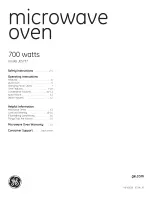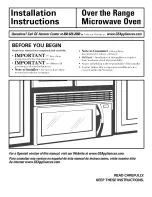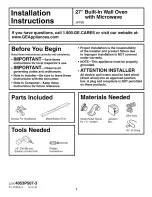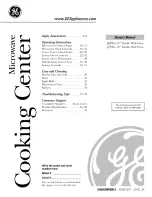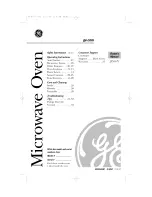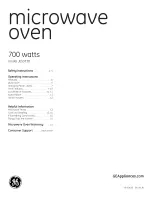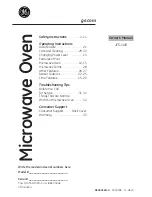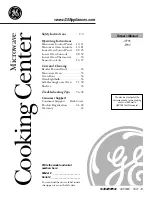
Bef
ore Operation
6
Cookware and Utensil Guide
Plastics
Plastic dishes, cups and some freezer
containers should be used with care in a
microwave oven. Choose plastic containers carefully,
as some plastic containers may become soft, melt
and scorch.
The majority of plastic dishes, even those designed
for use in the microwave oven, are not suitable for
cooking foods with high fat or sugar content, or for
lengthy cooking time. Most microwave plastic dishes
should not be used for longer than 3 to 5 minutes on
HIGH power. These dishes, although not suitable for
extended cooking, may be successfully used for
defrosting or for use on lower power levels.
Cooking Bags designed to withstand boiling,
freezing, or conventional heating are microwave
safe. Prepare bags according to manufacturers'
directions. When cooking by microwave, DO NOT
use wire twist-ties to close bag. They can act as an
antenna and cause arcing (sparks).
DO NOT COOK IN PLASTIC FOOD STORAGE
BAGS.
Plastic Wrap such as GLAD WRAP® can be used
to cover dishes in most recipes. Over an extended
heating time, some disfiguration of the wrap may
occur. When removing plastic wrap "covers" as well
as any glass lid be careful to remove it away from
you to avoid steam burns.
Loosen plastic but let dish stand covered.
Browning Dishes
NOTE: Browning dishes are no longer available.
This information is supplied to assist people who
already own a browning dish.
Browning dishes are used to sear chops, meat
patties, steaks etc. A special coating on the bottom
of the dish absorbs the microwave energy and
becomes very hot. When foods are added to the
dish, the result is a seared effect. Preheat the dish
according to the manufacturers' directions. Add food
to be seared and heat according to recipe or
personal preference. Use pot holders to remove the
dish from the Microwave Oven. Do not use the
browning dish on or in a conventional stove.
Remember:
Food can be covered with a loose sheet of
absorbent towel to prevent splattering.
Do not attempt to deep fry in the browning dish or
microwave oven as you cannot control the
temperature of the oil.
Metal
Metal cookware or utensils, and those with metallic
trim, should NOT be used on microwave. Since
microwave energy is reflected by metal, foods in
metal containers will not cook evenly. There is also
the possibility of "arcing".
Although metal utensils must be avoided in
microwave cooking, some metal can be helpful
when used correctly.
Aluminium foil can be used safely, if certain
guidelines are followed, to prevent overcooking.
Small pieces of foil are used to cover areas such as
chicken wings, tips of roasts, or other thin parts that
cook before the rest of the recipe is finished. Make
sure foil is attached securely and doesn't touch
sides of oven; otherwise arcing may occur.
Foil lined containers, either cardboard or plastic,
should NOT be used in the microwave oven as
arcing could occur.
Metal twist-ties, either paper or plastic coated,
should NOT be used on Microwave or Combination.
Frozen dinner trays can be used on Microwave if the
container is no deeper than 2 cm and is filled with
food. They may be used on Convection.
Metal skewers can not be used on Microwave as
arcing may occur. Wooden skewers are readily
available and give the same result.
Shells: Scalloped baking shells are best used
during reheating and for short periods of cooking
time only.
Thermometers are available for use in microwave
ovens. DO NOT USE CONVENTIONAL MERCURY
TYPE CANDY OR MEAT THERMOMETERS in food
while cooking in the microwave oven or on
Combination.
Jars and Bottles
Jars and Bottles can be used to warm food to
serving temperature, if the lid is removed first.
Cooking should not be done in these containers
since most are not heat resistant and during
extended heating times, heat from food would cause
cracking or breaking.
Straw, Wicker, and Wood
Straw and wicker baskets may be used in the
microwave oven for a short period of time to warm
rolls or bread. Large wooden utensils, such as bowls
or cutting boards should NOT be used for prolonged
heating as the microwave energy may cause the
wood to become dry and brittle.
























